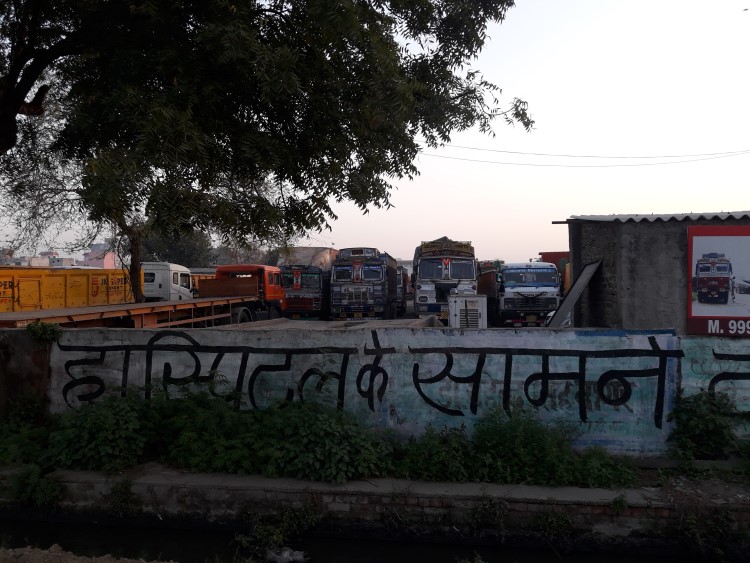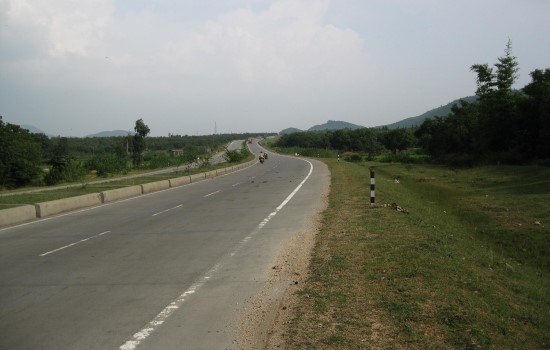Truck laybys or parking yards are vital from the road safety angle. Studies at home and abroad have conclusively showcased how a tired truck driver is a ticking bomb behind the wheels on highways
 LOGISTICS MONITOR
LOGISTICS MONITOR
By Ramesh Kumar
The Afghan Sur dynasty founder and emperor Sher Shah Suri (1537-45 AD), who upended the Mughal chapter in Indian history, was truly trade- and travel-friendly. Otherwise, he had no rationale to enhance the patchy pathway linking Kabul, Afghanistan, with Teknaf, Bangladesh, approximately 2,400km in the ancient Bharat. The British considerably rebuilt this ancient and longest road, dating back 2,500 years. From time immemorial, Grand Trunk Road, as it is called, has served traders and invaders.
The British, who usurped power from the Muslim invaders, refocused and rededicated on better pathways for strategic purposes as in the past: prosperity and security, enabling trading, and securing conquered territories. Even in the pre-motorized era, before the word ‘globalization’ became the catchphrase, horse- and camel-driven caravans traveled long distances; the weary travelers – merchants and others – needed resting places called sarais en route. Many were built, no doubt.
 “In every sarai, he (Sher Shah Suri) built separate lodgings, both for Hindus and Musulmans and, at the gate of every sarai, he had placed pots full of water, that anyone might drink; and in every sarai, he settled Brahmins for the entertainment of Hindus to provide hot and cold water, and beds and food, and grain for their horses, and it was a rule in these sarais, that whoever entered them received provision suitable to his rank and food and litter for his cattle, from the government. Villages were established all around the sarais. In the middle of every sarai was a well and a masjid of burnt brick; and he placed an imam and a muazzin in every masjid, together with several watchmen; and all these maintained from the land near the sarai,” (1) quotes Raghubir Singh.
“In every sarai, he (Sher Shah Suri) built separate lodgings, both for Hindus and Musulmans and, at the gate of every sarai, he had placed pots full of water, that anyone might drink; and in every sarai, he settled Brahmins for the entertainment of Hindus to provide hot and cold water, and beds and food, and grain for their horses, and it was a rule in these sarais, that whoever entered them received provision suitable to his rank and food and litter for his cattle, from the government. Villages were established all around the sarais. In the middle of every sarai was a well and a masjid of burnt brick; and he placed an imam and a muazzin in every masjid, together with several watchmen; and all these maintained from the land near the sarai,” (1) quotes Raghubir Singh.
He cites how Emperor Ashoka commanded that rest houses be constructed at every eight krosa (one krosa = a distance of about two miles and a quarter. Krośa is defined in the “Indian epigraphical glossary” as found on ancient inscriptions commonly written in Sanskrit, Prakrit, or Dravidian languages).
Another Indian king Harsha had created many charitable houses so that “wayfarers never found themselves in difficult straits”.
Sher Shah Suri was believed to have built 1,700 shelters on the imperial highway.
These historical nuggets flood my mind as I roam across the 20km stretch of the Grand Trunk Road (National Highway 91) in mid-February 2022 to witness what obtains 700 years after Sher Shah Suri’s reign ended.

From the spot where the Bulandshahr Industrial Area, housing thousands of small and medium enterprises on the outskirts of Ghaziabad, and up to the Aligarh bypass, circumventing the crowded Dadri town stretch, covering approximately 20km on the historical – rather ancient Grand Trunk Road, one cannot escape noticing trucks parked on both sides of the four-lane highway.
One of the dirtiest patches of the National Highway. There are steel and rice mills and multiple warehouses. The non-stop flow of commercial and passenger vehicles in both directions should not be forgotten.
There are no sarais, for sure, to provide free resting places for weary travelers. The stretch, dotted with logistic companies, was unsurprising. After all, it is a key trading route. Eateries are aplenty. Again private businesses. No caravans of yore. But plying trucks represent trade and commerce, ferrying various materials in both directions. Do these logistic service providers (truck drivers for the uninitiated) have access to better sarai-type facilities because long haul trucking is a back-breaking chore?
On this 20km stretch, I spot half a dozen fee-based private truck parking yards to cater to the needy. There is a huge space, and each of them accommodates at least 200-300 12-tire commercial vehicles. Of course, round the clock with a truckers’ dhaba (eatery) near the entrance, whose hygiene is questionable. Toilets? Yes. Maintained? So-so.
The users are to be partly blamed for such conditions. Do these user-drivers throw bidis/cigarettes inside toilets at home? Do they spit wherever they are away from work? Do they dump empty cheap liquor bottles or plastic sachet there? Do they scribble dirty things on the toilet wall at home? Above all, do they or do they not keep their toilets at home neat and clean by ensuring no feces float in the bowl? Mind you, and there is no water scarcity. It appears they have double standards. They prefer neat, clean, hygienic defecation rooms (assuming they have one!) voluntarily or under pressure from family member-users. Once out on the road and work, all these etiquettes go through the roof. Sad, indeed.
Given India’s geographical size and the trade volume (merchandise export in the financial year 2021-22: US$400bn for the first time in history), the movement of physical volume is humungous. Sixteen percent of GDP out of US$2.5trillion comes from manufacturing involving procurement and movement of raw material from multiple locations to the manufacturing site and finally dispatching finished goods to the nooks and corners of mera bharat mahaan. Two-thirds of this movement for exports and domestic consumption is on roads; via trucks of various sizes consisting of the long, medium, short, and first and last-mile delivery types.
Less said about the ergonomics of Indian trucks, the better. Of course, the entry of global trucking companies has jolted the lethargic home-grown biggies, viz., Tatas and Leylands, out of their deep slumber to pay greater attention to driver cabin comfort of late. Good for their concern for the less-privileged truck drivers.
On the government part, the National Highways Authority of India talks a lot about wayside amenities for long-haul truck drivers. Action on the ground is speeding at a snail’s pace! The location of some of the truck laybys on the lips of highways is not well-thought-out. Thus, many of them remain unutilized. Taxpayers’ money wasted, yes.
Truck laybys or parking yards are vital from the road safety angle. Studies at home and abroad have conclusively showcased how a tired truck driver is a ticking bomb behind the wheels on highways. Before jumping to a conclusion, let it be clear that India does not hold global rights for such apathy towards parking yards or restrooms for long-haul truck drivers. It is a universal challenge. Don’t believe it?

Inadequate truck parking over the past several decades is why truckers have left the industry, contributing to the nationwide shortage of roughly 80,000 drivers that has exacerbated global supply chain issues, CNBC reported in one of its recent dispatches about the American trucking scenario. (2)
The American Trucking Associations and the Owner-Operator Independent Drivers Association asked the US Department of Transportation to use funding from the federal infrastructure bill to construct designated parking areas for truckers to improve safety and working conditions.
Politicians everywhere are made of the same material. They blabber a lot. And try to legislate. But little action on the ground. For instance, the American parliament (House of Representatives) introduced The Truck Parking Safety Act for a US$755mn truck parking capacity. Yes, the Bill was introduced. Until today, no meetings have taken place regarding this Bill to materialize the wish.
The American Transportation Research Institute found that, on average, truck drivers spend nearly an hour per day looking for a parking space, which equates to about US$5000 annually in lost wages. Indian truck drivers never even look for one because of their non-existence, if not scarcity! The oil marketing companies tie access to securitized parking yards at select locations for a fee in the “fill up your fuel tank and park” strategy!
The current Biden Administration is trying to revive the Covid-hit American economy with a massive Infrastructure Bill with bipartisan support. But experts point out that the Bill has not made provisions specifically for truck parking. US Transport Secretary Pete Buttigieg (India’s Nitin Gadkari’s counterpart) defended, saying that federal funding for expanded truck parking is available from several sources.
Without exception, every country on Planet Earth mentions transportation as the backbone of the economy. Therefore, drivers form a critical element of this subset. By and large, trucking is deregulated – meaning there is an open competition. To stay afloat with falling freight rates and burgeoning driver shortage, the animal spirit among stakeholders needs no elaboration.
Trying to slash the logistic cost from 14% to 9% over the next five years as part of India’s proposed National Logistics Policy, driver comfort and road safety are not getting adequate attention. Truck parking yards on the highways are vital for the trucking business’s survival, safety, and prosperity. Why only trucking? Even the entire economy, frankly.

“A confluence of short-term shocks and long-term stresses have put our supply chains to the test. Decades of underinvestment in our transportation infrastructure have forced us to move an unprecedented volume of goods on infrastructure that was not built to handle it. Nearly a half-century of deregulation and consolidation has, in certain sectors, led to worse service, higher costs, and poorer working conditions. The rise of e-commerce has changed our lives for the better, but the reality is that our freight system was not built for a world where anyone can order anything to be delivered to their door with a couple of taps on their phone.” That was Buttigieg addressing his fellow policy-makers and stakeholders recently. What he dwelt in Washington holds good for India.
Let’s not sidestep the dedicated truck parking on highways claiming it has nothing to do with most of us: everyone excluding truck drivers. It has wider ramifications and an economic cost. Listen to Dr. Michael Belzer: “The implications of deregulation for the US economy and our values as a society are substantial. The trucking story is an allegory, telling us a cautionary tale of unfettered competition, creating a social dilemma that, extended to other industries, could have significant consequences for the American way of life.”
Before writing Sweatshops on Wheels: Winners and Losers in Trucking Deregulation (Oxford University Press, 2000), Belzer drove 750,000miles over 10 years on the American highways as a truck driver. So, it was not an armchair observation but arising out of pure hard-on-ground work.
It is time for the Indian government and stakeholders to wake up and work collectively to realize their dream basket: climate control, sustainability, and social justice. Of course, remove logistic inefficiencies in the entire spectrum and become globally competitive.
Globally competitive? Yes. Despite all the hullabaloo over the death of globalization, such an eventuality is unthinkable and unrealisable.
[Main/featured pic on top: Grand Trunk Road towards Burdwan from Hooghly/Wikipedia]
Also read by the same author: Relax. Experience tells us that the EV battery will outlive the car! – THE NEWS PORTER
Ref:
(1) The Grand Trunk Road: A Passage Through India, Raghubir Singh
(2) https://www.nbcnews.com/news/truck-drivers-push-infrastructure-dollars-expand-parking-capacity-rcna17744
The author is a business journalist specializing in logistics and supply chain. He has traveled 200,000 km on the Indian highways, met over 100,000 long-haul truck drivers across India since January 2010. He has authored three books: 10,000KM on Indian Highways, Naked Banana! and An Affair With Indian Highways. He is a Life Member of the Chartered Institute of Logistics & Transportation (CILT-India Chapter). He can be reached at konsultramesh@gmail.com. In this column, ‘Logistics Monitor’, he presents a global perspective on logistics and supply chain. The views are the author’s own and The News Porter bears no responsibility for the same.












More Stories
When Rajesh Khanna left the shoot mid-way, told scribe, ‘I’m going for a screw’
Of the Northern Lights and an Adventure with Huskies in Swedish Lapland!
1st April question: Is April Fool’s Day indeed a fool’s day?